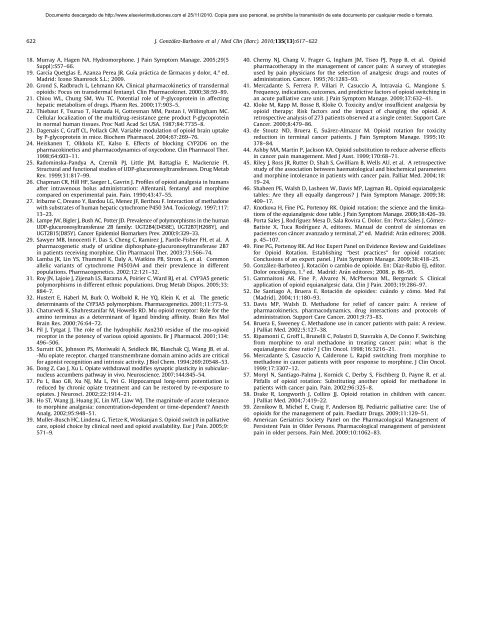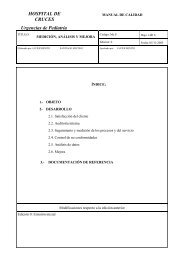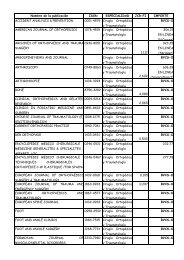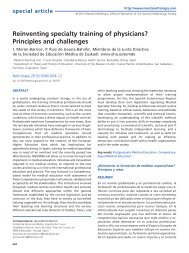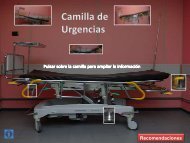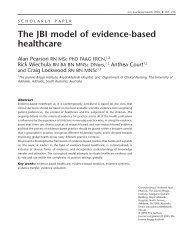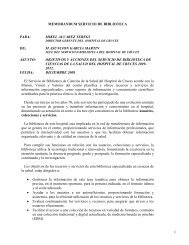Rotación de opioides - EXTRANET - Hospital Universitario Cruces
Rotación de opioides - EXTRANET - Hospital Universitario Cruces
Rotación de opioides - EXTRANET - Hospital Universitario Cruces
You also want an ePaper? Increase the reach of your titles
YUMPU automatically turns print PDFs into web optimized ePapers that Google loves.
Documento <strong>de</strong>scargado <strong>de</strong> http://www.elsevierinsituciones.com el 25/11/2010. Copia para uso personal, se prohíbe la transmisión <strong>de</strong> este documento por cualquier medio o formato.<br />
622<br />
J. González-Barboteo et al / Med Clin (Barc). 2010;135(13):617–622<br />
18. Murray A, Hagen NA. Hydromorphone. J Pain Symptom Manage. 2005;29(5<br />
Suppl):S57–66.<br />
19. García Quetglas E, Azanza Perea JR. Guía práctica <strong>de</strong> fármacos y dolor, 4. a ed.<br />
Madrid: Icono Shamrock S.L.; 2009.<br />
20. Grond S, Radbruch L, Lehmann KA. Clinical pharmacokinetics of trans<strong>de</strong>rmal<br />
opioids: Focus on trans<strong>de</strong>rmal fentanyl. Clin Pharmacokinet. 2000;38:59–89.<br />
21. Chiou WL, Chung SM, Wu TC. Potential role of P-glycoprotein in affecting<br />
hepatic metabolism of drugs. Pharm Res. 2000;17:903–5.<br />
22. Thiebaut F, Tsuruo T, Hamada H, Gottesman MM, Pastan I, Willingham MC.<br />
Cellular localization of the multidrug-resistance gene product P-glycoprotein<br />
in normal human tissues. Proc Natl Acad Sci USA. 1987;84:7735–8.<br />
23. Dagenais C, Graff CL, Pollack GM. Variable modulation of opioid brain uptake<br />
by P-glycoprotein in mice. Biochem Pharmacol. 2004;67:269–76.<br />
24. Heiskanen T, Olkkola KT, Kalso E. Effects of blocking CYP2D6 on the<br />
pharmacokinetics and pharmacodynamics of oxycodone. Clin Pharmacol Ther.<br />
1998;64:603–11.<br />
25. Radominska-Pandya A, Czernik PJ, Little JM, Battaglia E, Mackenzie PI.<br />
Structural and functional studies of UDP-glucuronosyltransferases. Drug Metab<br />
Rev. 1999;31:817–99.<br />
26. Chapman CR, Hill HF, Saeger L, Gavrin J. Profiles of opioid analgesia in humans<br />
after intravenous bolus administration: Alfentanil, fentanyl and morphine<br />
compared on experimental pain. Pain. 1990;43:47–55.<br />
27. Iribarne C, Dreano Y, Bardou LG, Menez JF, Berthou F. Interaction of methadone<br />
with substrates of human hepatic cytochrome P450 3A4. Toxicology. 1997;117:<br />
13–23.<br />
28. Lampe JW, Bigler J, Bush AC, Potter JD. Prevalence of polymorphisms in the human<br />
UDP-glucuronosyltransferase 2B family: UGT2B4(D458E), UGT2B7(H268Y), and<br />
UGT2B15(D85Y). Cancer Epi<strong>de</strong>miol Biomarkers Prev. 2000;9:329–33.<br />
29. Sawyer MB, Innocenti F, Das S, Cheng C, Ramirez J, Pantle-Fisher FH, et al. A<br />
pharmacogenetic study of uridine diphosphate-glucuronosyltransferase 2B7<br />
in patients receiving morphine. Clin Pharmacol Ther. 2003;73:566–74.<br />
30. Lamba JK, Lin YS, Thummel K, Daly A, Watkins PB, Strom S, et al. Common<br />
allelic variants of cytochrome P4503A4 and their prevalence in different<br />
populations. Pharmacogenetics. 2002;12:121–32.<br />
31. Roy JN, Lajoie J, Zijenah LS, Barama A, Poirier C, Ward BJ, et al. CYP3A5 genetic<br />
polymorphisms in different ethnic populations. Drug Metab Dispos. 2005;33:<br />
884–7.<br />
32. Hustert E, Haberl M, Burk O, Wolbold R, He YQ, Klein K, et al. The genetic<br />
<strong>de</strong>terminants of the CYP3A5 polymorphism. Pharmacogenetics. 2001;11:773–9.<br />
33. Chaturvedi K, Shahrestanifar M, Howells RD. Mu opioid receptor: Role for the<br />
amino terminus as a <strong>de</strong>terminant of ligand binding affinity. Brain Res Mol<br />
Brain Res. 2000;76:64–72.<br />
34. Pil J, Tytgat J. The role of the hydrophilic Asn230 residue of the mu-opioid<br />
receptor in the potency of various opioid agonists. Br J Pharmacol. 2001;134:<br />
496–506.<br />
35. Surratt CK, Johnson PS, Moriwaki A, Seidleck BK, Blaschak CJ, Wang JB, et al.<br />
-Mu opiate receptor. charged transmembrane domain amino acids are critical<br />
for agonist recognition and intrinsic activity. J Biol Chem. 1994;269:20548–53.<br />
36. Dong Z, Cao J, Xu L. Opiate withdrawal modifies synaptic plasticity in subicularnucleus<br />
accumbens pathway in vivo. Neuroscience. 2007;144:845–54.<br />
37. Pu L, Bao GB, Xu NJ, Ma L, Pei G. Hippocampal long-term potentiation is<br />
reduced by chronic opiate treatment and can be restored by re-exposure to<br />
opiates. J Neurosci. 2002;22:1914–21.<br />
38. Ho ST, Wang JJ, Huang JC, Lin MT, Liaw WJ. The magnitu<strong>de</strong> of acute tolerance<br />
to morphine analgesia: concentration-<strong>de</strong>pen<strong>de</strong>nt or time-<strong>de</strong>pen<strong>de</strong>nt? Anesth<br />
Analg. 2002;95:948–51.<br />
39. Muller-Busch HC, Lin<strong>de</strong>na G, Tietze K, Woskanjan S. Opioid switch in palliative<br />
care, opioid choice by clinical need and opioid availability. Eur J Pain. 2005;9:<br />
571–9.<br />
40. Cherny NJ, Chang V, Frager G, Ingham JM, Tiseo PJ, Popp B, et al. Opioid<br />
pharmacotherapy in the management of cancer pain: A survey of strategies<br />
used by pain physicians for the selection of analgesic drugs and routes of<br />
administration. Cancer. 1995;76:1283–93.<br />
41. Mercadante S, Ferrera P, Villari P, Casuccio A, Intravaia G, Mangione S.<br />
Frequency, indications, outcomes, and predictive factors of opioid switching in<br />
an acute palliative care unit. J Pain Symptom Manage. 2009;37:632–41.<br />
42. Kloke M, Rapp M, Bosse B, Kloke O. Toxicity and/or insufficient analgesia by<br />
opioid therapy: Risk factors and the impact of changing the opioid. A<br />
retrospective analysis of 273 patients observed at a single center. Support Care<br />
Cancer. 2000;8:479–86.<br />
43. <strong>de</strong> Stoutz ND, Bruera E, Suárez-Almazor M. Opioid rotation for toxicity<br />
reduction in terminal cancer patients. J Pain Symptom Manage. 1995;10:<br />
378–84.<br />
44. Ashby MA, Martin P, Jackson KA. Opioid substitution to reduce adverse effects<br />
in cancer pain management. Med J Aust. 1999;170:68–71.<br />
45. Riley J, Ross JR, Rutter D, Shah S, Gwilliam B, Wells AU, et al. A retrospective<br />
study of the association between haematological and biochemical parameters<br />
and morphine intolerance in patients with cancer pain. Palliat Med. 2004;18:<br />
19–24.<br />
46. Shaheen PE, Walsh D, Lasheen W, Davis MP, Lagman RL. Opioid equianalgesic<br />
tables: Are they all equally dangerous? J Pain Symptom Manage. 2009;38:<br />
409–17.<br />
47. Knotkova H, Fine PG, Portenoy RK. Opioid rotation: the science and the limitations<br />
of the equianalgesic dose table. J Pain Symptom Manage. 2009;38:426–39.<br />
48. Porta Sales J, Rodríguez Mesa D, Sala Rovira C. Dolor. En: Porta Sales J, Gómez-<br />
Batiste X, Tuca Rodríguez A, editores. Manual <strong>de</strong> control <strong>de</strong> síntomas en<br />
pacientes con cáncer avanzado y terminal, 2 a ed. Madrid: Arán editores; 2008.<br />
p. 45–107.<br />
49. Fine PG, Portenoy RK. Ad Hoc Expert Panel on Evi<strong>de</strong>nce Review and Gui<strong>de</strong>lines<br />
for Opioid Rotation. Establishing ‘‘best practices’’ for opioid rotation:<br />
Conclusions of an expert panel. J Pain Symptom Manage. 2009;38:418–25.<br />
50. González-Barboteo J. Rotación o cambio <strong>de</strong> opioi<strong>de</strong>. En: Díaz-Rubio EJ, editor.<br />
Dolor oncológico, 1. a ed. Madrid: Arán editores; 2008. p. 86–95.<br />
51. Gammaitoni AR, Fine P, Alvarez N, McPherson ML, Bergmark S. Clinical<br />
application of opioid equianalgesic data. Clin J Pain. 2003;19:286–97.<br />
52. De Santiago A, Bruera E. Rotación <strong>de</strong> opioi<strong>de</strong>s: cuándo y cómo. Med Pal<br />
(Madrid). 2004;11:180–93.<br />
53. Davis MP, Walsh D. Methadone for relief of cancer pain: A review of<br />
pharmacokinetics, pharmacodynamics, drug interactions and protocols of<br />
administration. Support Care Cancer. 2001;9:73–83.<br />
54. Bruera E, Sweeney C. Methadone use in cancer patients with pain: A review.<br />
J Palliat Med. 2002;5:127–38.<br />
55. Ripamonti C, Groff L, Brunelli C, Polastri D, Stavrakis A, De Conno F. Switching<br />
from morphine to oral methadone in treating cancer pain: what is the<br />
equianalgesic dose ratio? J Clin Oncol. 1998;16:3216–21.<br />
56. Mercadante S, Casuccio A, Cal<strong>de</strong>rone L. Rapid switching from morphine to<br />
methadone in cancer patients with poor response to morphine. J Clin Oncol.<br />
1999;17:3307–12.<br />
57. Moryl N, Santiago-Palma J, Kornick C, Derby S, Fischberg D, Payne R, et al.<br />
Pitfalls of opioid rotation: Substituting another opioid for methadone in<br />
patients with cancer pain. Pain. 2002;96:325–8.<br />
58. Drake R, Longworth J, Collins JJ. Opioid rotation in children with cancer.<br />
J Palliat Med. 2004;7:419–22.<br />
59. Zernikow B, Michel E, Craig F, An<strong>de</strong>rson BJ. Pediatric palliative care: Use of<br />
opioids for the management of pain. Paediatr Drugs. 2009;11:129–51.<br />
60. American Geriatrics Society Panel on the Pharmacological Management of<br />
Persistent Pain in Ol<strong>de</strong>r Persons. Pharmacological management of persistent<br />
pain in ol<strong>de</strong>r persons. Pain Med. 2009;10:1062–83.


